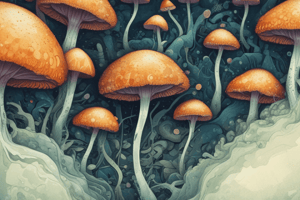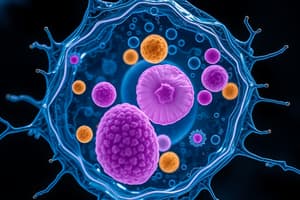Podcast
Questions and Answers
What is the primary function of the Golgi apparatus in a cell?
What is the primary function of the Golgi apparatus in a cell?
- Protein synthesis
- Storage and transport of molecules
- Sorting, tagging, packaging, and distribution of lipids and proteins (correct)
- Oxidation reactions that break down fatty acids and amino acids
What is the name of the scientific discipline that deals with the study of fungi?
What is the name of the scientific discipline that deals with the study of fungi?
- Botany
- Microbiology
- Biotechnology
- Mycology (correct)
What is the term for diseases caused by fungi?
What is the term for diseases caused by fungi?
- Fungemia
- Mycotoxicosis
- Mycoses (correct)
- Fungal infections
What is the term for the web-like structure of hyphae?
What is the term for the web-like structure of hyphae?
What is the function of substrate mycelia?
What is the function of substrate mycelia?
What is the term for the study of the structure of fungi?
What is the term for the study of the structure of fungi?
What is the term for the basic element of filamentous fungi?
What is the term for the basic element of filamentous fungi?
How do fungi obtain their nutrition in the saprophytic mode?
How do fungi obtain their nutrition in the saprophytic mode?
Which classification system of fungi is based on geographic distribution?
Which classification system of fungi is based on geographic distribution?
What is the mode of nutrition of fungi that obtains their nutrition by living on other living organisms?
What is the mode of nutrition of fungi that obtains their nutrition by living on other living organisms?
Which group of fungi is classified based on the mode of transmission of fungal diseases?
Which group of fungi is classified based on the mode of transmission of fungal diseases?
What is the process by which fungi produce spores?
What is the process by which fungi produce spores?
Which of the following is an example of a fungus that obtains its nutrition by feeding on dead organic substances?
Which of the following is an example of a fungus that obtains its nutrition by feeding on dead organic substances?
How many divisions are fungi classified into based on morphologic and cultural characteristics?
How many divisions are fungi classified into based on morphologic and cultural characteristics?
What is the primary component that 10-20% KOH dissolves in a skin scraping specimen?
What is the primary component that 10-20% KOH dissolves in a skin scraping specimen?
Which of the following fungi is responsible for causing Pityriasis versicolor?
Which of the following fungi is responsible for causing Pityriasis versicolor?
What is the primary purpose of incubating fungal cultures for 2-3 weeks?
What is the primary purpose of incubating fungal cultures for 2-3 weeks?
What is the name of the agar medium used to support fungal growth in the laboratory?
What is the name of the agar medium used to support fungal growth in the laboratory?
Which of the following is NOT a specimen type used in laboratory diagnosis of fungal infections?
Which of the following is NOT a specimen type used in laboratory diagnosis of fungal infections?
What is the purpose of adding KOH to a skin scraping specimen?
What is the purpose of adding KOH to a skin scraping specimen?
Which of the following fungi causes Black piedra?
Which of the following fungi causes Black piedra?
What type of relationship do symbiotic fungi have with other species?
What type of relationship do symbiotic fungi have with other species?
What is the role of fungi in mycorrhizal relationships?
What is the role of fungi in mycorrhizal relationships?
Which type of fungi has a symbiotic association with algae?
Which type of fungi has a symbiotic association with algae?
What is the characteristic of the hyphae in Zygomycetes?
What is the characteristic of the hyphae in Zygomycetes?
What is the name of the sexual spores in Ascomycetes?
What is the name of the sexual spores in Ascomycetes?
Which type of fungi is known as sac fungi?
Which type of fungi is known as sac fungi?
What is the mode of asexual reproduction in Basidiomycetes?
What is the mode of asexual reproduction in Basidiomycetes?
What is the characteristic of the symbiotic relationship between fungi and algae in lichens?
What is the characteristic of the symbiotic relationship between fungi and algae in lichens?
What is the classification of fungi based on?
What is the classification of fungi based on?
What is the purpose of classifying fungi based on epidemiologic grouping?
What is the purpose of classifying fungi based on epidemiologic grouping?
What do fungi in the Ascomycota division include?
What do fungi in the Ascomycota division include?
How do fungi in the saprophytic mode obtain their nutrition?
How do fungi in the saprophytic mode obtain their nutrition?
What is the mode of nutrition of fungi that obtain their nutrition by living on other living organisms?
What is the mode of nutrition of fungi that obtain their nutrition by living on other living organisms?
How many divisions are fungi classified into based on morphologic and cultural characteristics?
How many divisions are fungi classified into based on morphologic and cultural characteristics?
What is the term for the mode of nutrition of fungi that obtain their nutrition by feeding on dead organic substances?
What is the term for the mode of nutrition of fungi that obtain their nutrition by feeding on dead organic substances?
What is the classification of fungi based on geographic distribution?
What is the classification of fungi based on geographic distribution?
What is the primary function of the endoplasmic reticulum in a cell?
What is the primary function of the endoplasmic reticulum in a cell?
What is the characteristic of mycelium?
What is the characteristic of mycelium?
What is the function of peroxisomes?
What is the function of peroxisomes?
What is the morphology of a hypha?
What is the morphology of a hypha?
Where do fungi obtain their nutrition?
Where do fungi obtain their nutrition?
What is the function of vesicles and vacuoles?
What is the function of vesicles and vacuoles?
What is the term for scientists who study fungi?
What is the term for scientists who study fungi?
What is the primary function of 10-20% KOH in a skin scraping specimen?
What is the primary function of 10-20% KOH in a skin scraping specimen?
What type of fungi is responsible for causing Pityriasis versicolor?
What type of fungi is responsible for causing Pityriasis versicolor?
What is the purpose of incubating fungal cultures for 2-3 weeks?
What is the purpose of incubating fungal cultures for 2-3 weeks?
What type of relationship do symbiotic fungi have with other species?
What type of relationship do symbiotic fungi have with other species?
What is the characteristic of the hyphae in Zygomycetes?
What is the characteristic of the hyphae in Zygomycetes?
What type of agar medium is used to support fungal growth in the laboratory?
What type of agar medium is used to support fungal growth in the laboratory?
What is the primary component of a skin scraping specimen that is digested by 10-20% KOH?
What is the primary component of a skin scraping specimen that is digested by 10-20% KOH?
What is the role of fungi in mycorrhizal relationships?
What is the role of fungi in mycorrhizal relationships?
What is the primary function of a KOH mount in laboratory diagnosis?
What is the primary function of a KOH mount in laboratory diagnosis?
What is the name of the sexual spores in Ascomycetes?
What is the name of the sexual spores in Ascomycetes?
Which of the following is a specimen type used in laboratory diagnosis of fungal infections?
Which of the following is a specimen type used in laboratory diagnosis of fungal infections?
Which type of fungi is known as sac fungi?
Which type of fungi is known as sac fungi?
What is the mode of asexual reproduction in Basidiomycetes?
What is the mode of asexual reproduction in Basidiomycetes?
What is the characteristic of the symbiotic relationship between fungi and algae in lichens?
What is the characteristic of the symbiotic relationship between fungi and algae in lichens?
What is the classification of fungi based on?
What is the classification of fungi based on?
Which type of fungi has a symbiotic association with algae?
Which type of fungi has a symbiotic association with algae?
Flashcards are hidden until you start studying
Study Notes
Cell Biology
- Endoplasmic reticulum: modifies proteins and synthesizes lipids
- Golgi apparatus: sorts, tags, packages, and distributes lipids and proteins
- Peroxisomes: small, round organelles that break down fatty acids and amino acids, and detoxify poisons
- Vesicles and vacuoles: membrane-bound sacs for storage and transport
Mycology
- Mycology: scientific discipline dealing with fungi
- Myco: fungus
- Mycoses: diseases caused by fungi
- Medical mycology: study of mycoses and their causes
- Mycologists: scientists who study fungi
Morphology
- Hypha: basic element of filamentous fungi, branched, tubular structure, 2-10 um in width
- Mycelium: web or mat-like structure of hyphae, with crosswalls that form compartments (± cells)
Reproduction
- Single spore can develop into a mycelium
- Fruiting bodies of fungi, such as mushrooms, can sprout from a mycelium
- Spores dispersed widely by wind or water, germinate in a moist place
Classification of Fungi
- Geographic grouping: classification by geographic distribution
- Epidemiologic grouping: concerned with how fungal disease is transmitted
- Taxonomy grouping: scientific grouping according to morphologic and cultural characteristics
- Divisions: Chytridiomycota, Zygomycota, Ascomycota, and Basidiomycota
Classification of Fungi (continued)
- Based on mode of nutrition:
- Saprophytic: obtain nutrition by feeding on dead organic substances
- Parasitic: obtain nutrition by living on other living organisms
- Symbiotic: live in a mutually beneficial relationship with other species
Fungal Disease
- Black piedra: caused by Piedraia hortae
- White piedra: caused by Trichosporon beigelii
- Pityriasis versicolor: caused by Malassezia furfur
- Tinea nigra: caused by Phaeoannellomyces werneckii
- Candidosis: caused by Candida albicans and Trichophyton
- Dermatophytosis: caused by Microsporum and Epidermophyton
Laboratory Diagnosis
- Specimens: skin scrapings, nail clippings, hairs, scrapings from mucous membrane, tissue biopsy, blood, CSF, etc.
- Microscopy: KOH mount, KOH dissolves keratin and cellular material, leaving fungi intact
- Fungal growth: cultures incubated for 2-3 weeks, examined macroscopically for colony morphology, and microscopically for fungal morphology
Classification of Fungi (continued)
- Based on spore formation:
- Zygomycetes: formed by fusion of two cells, asexual spores are sporangiospores, hyphae are without septa
- Ascomycetes: also called sac fungi, sexual spores are ascospores, asexual reproduction occurs by conidiospores
- Basidiomycetes: mushrooms, sexual reproduction occurs by basidiospores, asexual reproduction occurs by conidia, budding, or fragmentation
Cell Biology
- Endoplasmic reticulum: modifies proteins and synthesizes lipids
- Golgi apparatus: sorts, tags, packages, and distributes lipids and proteins
- Peroxisomes: small, round organelles that break down fatty acids and amino acids, and detoxify poisons
- Vesicles and vacuoles: membrane-bound sacs for storage and transport
Mycology
- Mycology: scientific discipline dealing with fungi
- Myco: fungus
- Mycoses: diseases caused by fungi
- Medical mycology: study of mycoses and their causes
- Mycologists: scientists who study fungi
Morphology
- Hypha: basic element of filamentous fungi, branched, tubular structure, 2-10 um in width
- Mycelium: web or mat-like structure of hyphae, with crosswalls that form compartments (± cells)
Reproduction
- Single spore can develop into a mycelium
- Fruiting bodies of fungi, such as mushrooms, can sprout from a mycelium
- Spores dispersed widely by wind or water, germinate in a moist place
Classification of Fungi
- Geographic grouping: classification by geographic distribution
- Epidemiologic grouping: concerned with how fungal disease is transmitted
- Taxonomy grouping: scientific grouping according to morphologic and cultural characteristics
- Divisions: Chytridiomycota, Zygomycota, Ascomycota, and Basidiomycota
Classification of Fungi (continued)
- Based on mode of nutrition:
- Saprophytic: obtain nutrition by feeding on dead organic substances
- Parasitic: obtain nutrition by living on other living organisms
- Symbiotic: live in a mutually beneficial relationship with other species
Fungal Disease
- Black piedra: caused by Piedraia hortae
- White piedra: caused by Trichosporon beigelii
- Pityriasis versicolor: caused by Malassezia furfur
- Tinea nigra: caused by Phaeoannellomyces werneckii
- Candidosis: caused by Candida albicans and Trichophyton
- Dermatophytosis: caused by Microsporum and Epidermophyton
Laboratory Diagnosis
- Specimens: skin scrapings, nail clippings, hairs, scrapings from mucous membrane, tissue biopsy, blood, CSF, etc.
- Microscopy: KOH mount, KOH dissolves keratin and cellular material, leaving fungi intact
- Fungal growth: cultures incubated for 2-3 weeks, examined macroscopically for colony morphology, and microscopically for fungal morphology
Classification of Fungi (continued)
- Based on spore formation:
- Zygomycetes: formed by fusion of two cells, asexual spores are sporangiospores, hyphae are without septa
- Ascomycetes: also called sac fungi, sexual spores are ascospores, asexual reproduction occurs by conidiospores
- Basidiomycetes: mushrooms, sexual reproduction occurs by basidiospores, asexual reproduction occurs by conidia, budding, or fragmentation
Studying That Suits You
Use AI to generate personalized quizzes and flashcards to suit your learning preferences.




